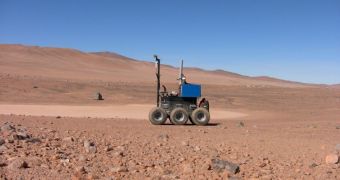Steering a rover located on the surface of another planet or moon is a very complex task, as demonstrated by the Mars Exploration Rovers (MER) mission and other robots. Now, the European Space Agency is making the first steps towards solving this problem.
In just 6 months, a team made up of top engineers at the agency was able to devise a way of enabling rovers on the surface of other celestial bodies to drive themselves. The process is fully autonomous.
The technology was tested this May, in the Atacama Desert, Chile. This location was selected because it's the most arid on Earth, but also because it is extremely similar to the Martian surface. ESA built a small rover that used the new steering software, and set it loose in the desert.
The full-scale exploration rover is called Seeker. It represents a demonstration of what can be achieved when a multidisciplinary team of scientists is put together at the same location, and made to work against the clock for achieving a specific innovation.
One of the main reasons why driving rovers located on other worlds is impractical is the time lag. Between Earth and Mars, for example, radio signals can spend up to 40 minutes en route, which means that each maneuver a rover makes has multiple delays.
What ESA is trying to achieve is the capability to give rovers a set of general guidelines and instructions, which the machine can then fulfill on its own, eliminating the need for frequent contacts with its human operators.
A similar system was installed by NASA on the MER Opportunity, the only rover of the mission that is still in operation. The robot now stops for instructions less frequently than it used to.
The challenge for the ESA engineering team “was to demonstrate how a planetary rover – programmed with state-of-the-art software for autonomous navigation and making decisions – could traverse 6 km in a Mars-like environment and come back where it started,” ESA expert Gianfranco Visentin says.
“ESA’s ExoMars rover, due to land on Mars in 2018, will have state-of-the-art autonomy. However, it will not travel more than 150 m each Martian day and not much more than 3 km throughout its mission,” he goes on to say, quoted by Astrobiology Magazine.

 14 DAY TRIAL //
14 DAY TRIAL //